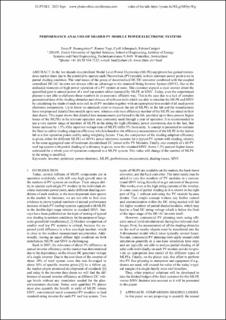Please use this identifier to cite or link to this item:
https://doi.org/10.21256/zhaw-23261| Publication type: | Conference paper |
| Type of review: | Peer review (abstract) |
| Title: | Performance analysis of shaded PV module power electronic systems |
| Authors: | Baumgartner, Franz Vogt, Roman Allenspach, Cyril Armand Carigiet, Fabian |
| et. al: | No |
| DOI: | 10.4229/EUPVSEC20212021-4CO.3.1 10.21256/zhaw-23261 |
| Proceedings: | Proceedings of the 38th EUPVSEC |
| Page(s): | 650 |
| Pages to: | 654 |
| Conference details: | 38th European Photovoltaic Solar Energy Conference and Exhibition (EUPVSEC), online, 6-10 September 2021 |
| Issue Date: | Sep-2021 |
| Publisher / Ed. Institution: | WIP |
| Publisher / Ed. Institution: | München |
| ISBN: | 3-936338-78-7 |
| ISSN: | 2196-100X |
| Language: | English |
| Subjects: | Inverter; Optimizer; Power electronic; MLPE; Performance; Measurement; Shading loss; SINV |
| Subject (DDC): | 621.3: Electrical, communications, control engineering |
| Abstract: | In the last decade decentralized Modul Level Power Electronics (MLPE) equipment has gained tremendous market share due to the potential to operate each Photovoltaic (PV) module in their optimum power point even in partial shading condition. The total losses of the group of decentralised DC/DC converter combined with the coupled centralised DC/AC inverter not always offer an advantage to the standard String Inverter System (SINV), like in the unshaded moments of high-power operation of a PV system at noon. The customer expects a clear answer about the quantified gain in annual power of a roof top system either operated by MLPE or SINV. Today, even the experienced planner is not able to elaborate these numbers in an economic efficient way. This is the case due to a lack of complex geometrical data of the shading obstacles and absence of software tools which are able to simulate the MLPE and SINV by calculating the shade of each solar cell in all PV modules together with an appropriate loss model of all used power electronic components. Up to know no standards exist to measure the set of MLPEs in the lab and the manufactures have not proposed detailed loss models up to now, whereas only max efficiency number of the MLPE are stated in their data sheets. This paper shows that detailed loss measurements performed in the lab, provided up to three percent higher losses of the MLPEs in the relevant operation area commonly used through a year of operation. It is recommended to use a very narrow range of numbers of MLPE in the string for high efficiency power conversion, due to the fact, that losses increase by 1.5% if the input/out voltage ratio of MLPE differ 5% from unity. A concept is presented to estimate the final so-called shading adaption efficiency which is based on the efficiency measurement of the MLPE in the indoor lab at a few operation points and by using weighting factors. Thus, the comparison of the shading adaption efficiency is given, either for different MLPEs or SINVs power electronic systems for a typical PV system with shading, relative to the same aggregated sum of maximum decentralised DC power at the PV Modules. Finally, one example of a tilt PV roof top system with partial shading of a chimney is given, were the standard SINV shows 1.2% percent higher losses estimated for a whole year of operation compared to a MLPE system. This value will change if the number of MLPE in the string is modified. |
| Further description: | Video of the talk is available at: https://youtu.be/NlLg1MOyvWg |
| URI: | https://digitalcollection.zhaw.ch/handle/11475/23261 |
| Fulltext version: | Accepted version |
| License (according to publishing contract): | Licence according to publishing contract |
| Departement: | School of Engineering |
| Organisational Unit: | Institute of Energy Systems and Fluid Engineering (IEFE) |
| Published as part of the ZHAW project: | EFFPVSHADE – Effizienzanalyse von dezentraler Photovoltaik Leistungselektronik bei Teilbeschattung |
| Appears in collections: | Publikationen School of Engineering |
Files in This Item:
| File | Description | Size | Format | |
|---|---|---|---|---|
| 2021_Baumgartner-etal_Performance-analysis-shaded-PV.pdf | Accepted Version | 2.08 MB | Adobe PDF |  View/Open |
Show full item record
Baumgartner, F., Vogt, R., Allenspach, C. A., & Carigiet, F. (2021). Performance analysis of shaded PV module power electronic systems [Conference paper]. Proceedings of the 38th EUPVSEC, 650–654. https://doi.org/10.4229/EUPVSEC20212021-4CO.3.1
Baumgartner, F. et al. (2021) ‘Performance analysis of shaded PV module power electronic systems’, in Proceedings of the 38th EUPVSEC. München: WIP, pp. 650–654. Available at: https://doi.org/10.4229/EUPVSEC20212021-4CO.3.1.
F. Baumgartner, R. Vogt, C. A. Allenspach, and F. Carigiet, “Performance analysis of shaded PV module power electronic systems,” in Proceedings of the 38th EUPVSEC, Sep. 2021, pp. 650–654. doi: 10.4229/EUPVSEC20212021-4CO.3.1.
BAUMGARTNER, Franz, Roman VOGT, Cyril Armand ALLENSPACH und Fabian CARIGIET, 2021. Performance analysis of shaded PV module power electronic systems. In: Proceedings of the 38th EUPVSEC. Conference paper. München: WIP. September 2021. S. 650–654. ISBN 3-936338-78-7
Baumgartner, Franz, Roman Vogt, Cyril Armand Allenspach, and Fabian Carigiet. 2021. “Performance Analysis of Shaded PV Module Power Electronic Systems.” Conference paper. In Proceedings of the 38th EUPVSEC, 650–54. München: WIP. https://doi.org/10.4229/EUPVSEC20212021-4CO.3.1.
Baumgartner, Franz, et al. “Performance Analysis of Shaded PV Module Power Electronic Systems.” Proceedings of the 38th EUPVSEC, WIP, 2021, pp. 650–54, https://doi.org/10.4229/EUPVSEC20212021-4CO.3.1.
Items in DSpace are protected by copyright, with all rights reserved, unless otherwise indicated.